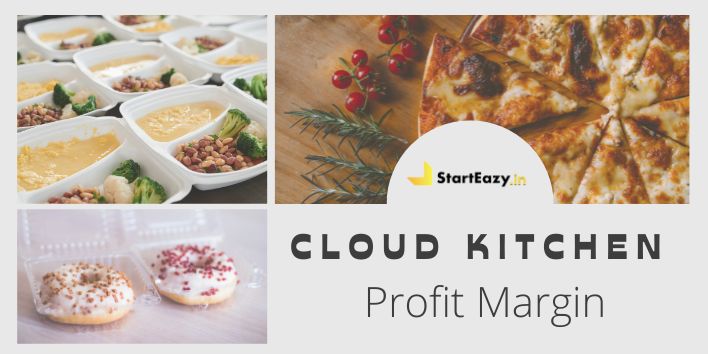Cloud Kitchen Profit Margin | The Ultimate Guide

When you think of cloud kitchens, names like Faasos (Rebel Foods), Biryani By Kilo, Eatsure, Freshmenu, Behrouz Biryani, and Oven Story might come to mind. These are some of the leading brands in the booming cloud kitchen industry. If you're contemplating investing in this innovative business model, understanding the cloud kitchen profit margin is crucial for making an informed decision.

What You’ll Learn in This Guide
-
Market Size of the Cloud Kitchen Industry
-
Average Cloud Kitchen Profit Margin
-
Minimum Investment Required for a Cloud Kitchen
-
Key Strategies to Maximize Profits
Market Size of the Cloud Kitchen Industry
The cloud kitchen industry is on a rapid growth trajectory. By 2027, it's projected to reach USD 71.4 billion, with a compound annual growth rate (CAGR) of 12% from 2021 to 2027. This growth is driven by the increasing demand for food delivery services, with even quick-service restaurants like Mad Over Donuts and Momo King embracing the cloud kitchen model.
Average Cloud Kitchen Profit Margin
Cloud kitchens have significant profit potential. On average, they achieve a profit margin of 20%-25%. However, profitability hinges on your order volume. For instance, handling 25-50 orders daily, each priced between Rs. 200-250, could result in a monthly income ranging from Rs. 2 lakhs to Rs. 4 lakhs. This translates to an average monthly profit of Rs. 50,000 - Rs. 90,000.
It's important to note that partnering with food delivery platforms like Swiggy or Zomato will incur a commission fee of 20%-25% plus GST. Keep this in mind when setting your menu prices.
Minimum Investment Required for a Cloud Kitchen
Starting a cloud kitchen typically requires an initial investment of Rs. 6 lakhs - Rs. 7 lakhs. This amount can vary based on several factors, including the size, scope, type of food offered, technology infrastructure, and location of your business.
Here’s a breakdown of common cloud kitchen costs:
Costs Associated with a Cloud Kitchen
Machinery and Equipment
To set up a cloud kitchen, you will need essential kitchen machinery and equipment. This includes items such as knives, cutting boards, a microwave, a refrigerator, pots, pans, and a burner.
These fundamental tools can cost between Rs. 70,000 and Rs. 90,000.
To minimize costs, consider purchasing second-hand equipment, which can offer significant savings without compromising on functionality.
Rent
Selecting an economical location is crucial for managing your expenses. A cost-effective option is to rent a commercial space or the top floor of a building.
For a cloud kitchen, you will require approximately 100 to 200 square feet of space. Rental costs vary widely depending on the city and can range from Rs. 8,000 to Rs. 25,000 per month.
Renting in Tier II and Tier III cities typically proves to be more budget-friendly compared to metropolitan areas.
TIP: It is advisable to negotiate a long-term lease. This approach can help you avoid frequent rent increases as your business grows and becomes more successful.
Legal Registration Costs
Starting a cloud kitchen involves several legal registrations and permits, which include:
-
Company Registration Online: Rs. 7,000 - Rs. 10,000
-
FSSAI License: Rs. 1,500 - Rs. 5,000
-
Trademark Registration (Online): Rs. 5,000 - Rs. 10,000
-
Trade License: Rs. 1,000 - Rs. 2,500
-
Gas Connection: Rs. 4,000 - Rs. 5,000
-
Fire NOC: Rs. 1,000 - Rs. 1,500
-
Electricity Connection: Rs. 20,000
In total, the legal registration costs are estimated to be between Rs. 35,000 and Rs. 40,000.
Raw Materials and Packaging Supplies
For the smooth operation of your cloud kitchen, you'll need to budget for raw materials and packaging supplies:
-
Raw Materials: Purchasing raw materials in bulk can lead to substantial savings. Allocate approximately Rs. 30,000 per month for these supplies. Building good relationships with vendors and negotiating prices can further reduce costs.
-
Packaging Supplies: Quality packaging is vital for maintaining the integrity of your food during delivery. The cost of packaging supplies typically ranges from Rs. 40,000 to Rs. 60,000. Ordering in larger quantities often results in a lower per-unit cost, so consider bulk purchases to optimize your budget.
Marketing
Market before you launch.
The best way to create buzz around your new cloud kitchen is to run ads on Facebook, Instagram and YouTube. This would cost a minimum of Rs. 10,000 initially.
Create awareness of your kitchen by allowing potential customers to register their interest with their contact information.
But will they give their phone number and other details?
To get customers to sign up for your product launch, think of something you can give away in return. It could be anything from a discount coupon to a gift. Get creative and let them know how much you value their loyalty by offering an irresistible incentive.
You can use tools like Canva for designing offers and posters. For the content part, you can use free AI writing tools like Copy.ai.
Key Strategies to Maximize Profits
Starting a cloud kitchen may be easy but running it successfully involves more than just setting up a kitchen. Here are key strategies to enhance your profitability:
-
Understand Customer Needs and Preferences: Tailor your menu to meet the demands and tastes of your target audience.
-
Leverage Technology: Utilize technology for marketing, operations, and customer engagement.
-
Focus on Customer Experience: Ensure exceptional service and quality to foster repeat business.
-
Optimize Delivery Costs: Efficient delivery management can significantly impact your profit margins.
-
Create an Efficient Pricing Strategy: Set competitive prices while accounting for all costs and desired profit margins.
By implementing these strategies, you can maximize the profitability of your cloud kitchen and maintain a competitive edge in the market.








